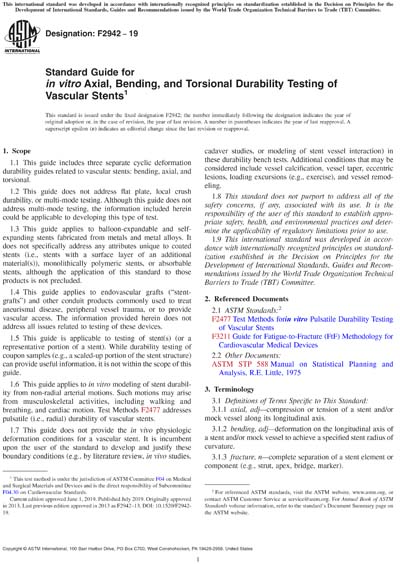Most recent
ASTM F2942-19
Standard Guide for in vitro Axial, Bending, and Torsional Durability Testing of Vascular Stents
1.1 This guide includes three separate cyclic deformation durability guides related to vascular stents: bending, axial, and torsional.
1.2 This guide does not address flat plate, local crush durability, or multi-mode testing. Although this guide does not address multi-mode testing, the information included herein could be applicable to developing this type of test.
1.3 This guide applies to balloon-expandable and self-expanding stents fabricated from metals and metal alloys. It does not specifically address any attributes unique to coated stents (i.e., stents with a surface layer of an additional material(s)), monolithically polymeric stents, or absorbable stents, although the application of this standard to those products is not precluded.
1.4 This guide applies to endovascular grafts (“stent-grafts”) and other conduit products commonly used to treat aneurismal disease, peripheral vessel trauma, or to provide vascular access. The information provided herein does not address all issues related to testing of these devices.
1.5 This guide is applicable to testing of stent(s) (or a representative portion of a stent). While durability testing of coupon samples (e.g., a scaled-up portion of the stent structure) can provide useful information, it is not within the scope of this guide.
1.6 This guide applies to in vitro modeling of stent durability from non-radial arterial motions. Such motions may arise from musculoskeletal activities, including walking and breathing, and cardiac motion. Test Methods F2477 addresses pulsatile (i.e., radial) durability of vascular stents.
1.7 This guide does not provide the in vivo physiologic deformation conditions for a vascular stent. It is incumbent upon the user of the standard to develop and justify these boundary conditions (e.g., by literature review, in vivo studies, cadaver studies, or modeling of stent vessel interaction) in these durability bench tests. Additional conditions that may be considered include vessel calcification, vessel taper, eccentric lesions, loading excursions (e.g., exercise), and vessel remodeling.
1.8 This standard does not purport to address all of the safety concerns, if any, associated with its use. It is the responsibility of the user of this standard to establish appropriate safety, health, and environmental practices and determine the applicability of regulatory limitations prior to use.
1.9 This international standard was developed in accordance with internationally recognized principles on standardization established in the Decision on Principles for the Development of International Standards, Guides and Recommendations issued by the World Trade Organization Technical Barriers to Trade (TBT) Committee.
Content Provider
ASTM International [astm]






